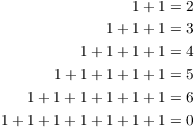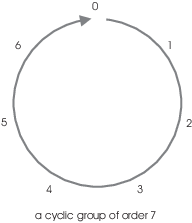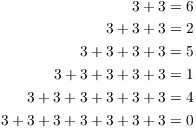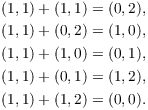Cyclic groups are groups in which every element is a power of some fixed element. (If the group is abelian and I'm using + as the operation, then I should say instead that every element is a multiple of some fixed element.) Here are the relevant definitions.
Definition. Let G be a group, ![]() . The order of g is the
smallest positive integer n such that
. The order of g is the
smallest positive integer n such that ![]() . If there is no
positive integer n such that
. If there is no
positive integer n such that ![]() , then g has infinite order.
, then g has infinite order.
In the case of an abelian group with + as the operation and 0 as the
identity, the order of g is the smallest positive integer n such that
![]() .
.
Definition. If G is a group and ![]() , then the subgroup generated
by g is
, then the subgroup generated
by g is
![]()
If the group is abelian and I'm using + as the operation, then
![]()
Definition. A group G is
cyclic if ![]() for some
for some ![]() . g is a generator of
. g is a generator of ![]() .
.
If a generator g has order n, ![]() is cyclic of order n. If a generator g has infinite
order,
is cyclic of order n. If a generator g has infinite
order, ![]() is infinite
cyclic.
is infinite
cyclic.
Example. ( The integers and
the integers mod n are cyclic) Show that ![]() and
and ![]() for
for ![]() are cyclic.
are cyclic.
![]() is an infinite cyclic group, because every element is
a multiple of 1 (or of -1). For instance,
is an infinite cyclic group, because every element is
a multiple of 1 (or of -1). For instance, ![]() .
.
(Remember that "![]() " is really shorthand for
" is really shorthand for
![]() --- 1 added to itself 117 times.)
--- 1 added to itself 117 times.)
In fact, it is the only infinite cyclic group up to isomorphism.
Notice that a cyclic group can have more than one generator.
If n is a positive integer, ![]() is a cyclic
group of order n generated by 1.
is a cyclic
group of order n generated by 1.
For example, 1 generates ![]() , since
, since

In other words, if you add 1 to itself repeatedly, you eventually cycle back to 0.

Notice that 3 also generates ![]() :
:

The "same" group can be written using multiplicative notation this way:
![]()
In this form, a is a generator of ![]() .
.
It turns out that in ![]() ,
every nonzero element generates the group.
,
every nonzero element generates the group.
On the other hand, in ![]() , only 1
and 5 generate.
, only 1
and 5 generate.![]()
Lemma. Let ![]() be a
finite cyclic group, where g has order n. Then the powers
be a
finite cyclic group, where g has order n. Then the powers ![]() are distinct.
are distinct.
Proof. Since g has order n, g, ![]() , ...
, ... ![]() are all different from 1.
are all different from 1.
Now I'll show that the powers ![]() are distinct. Suppose
are distinct. Suppose ![]() where
where ![]() . Then
. Then ![]() and
and ![]() , contrary to the preceding observation.
, contrary to the preceding observation.
Therefore, the powers ![]() are
distinct.
are
distinct.![]()
Lemma. Let ![]() be
infinite cyclic. If m and n are integers and
be
infinite cyclic. If m and n are integers and ![]() , then
, then ![]() .
.
Proof. One of m, n is larger --- suppose
without loss of generality that ![]() . I want to show
that
. I want to show
that ![]() ; suppose this is false, so
; suppose this is false, so ![]() . Then
. Then ![]() , so g has finite order. This
contradicts the fact that a generator of an infinite cyclic group has
infinite order. Therefore,
, so g has finite order. This
contradicts the fact that a generator of an infinite cyclic group has
infinite order. Therefore, ![]() .
.![]()
The next result characterizes subgroups of cyclic groups. The proof uses the Division Algorithm for integers in an important way.
Theorem. Subgroups of cyclic groups are cyclic.
Proof. Let ![]() be a
cyclic group, where
be a
cyclic group, where ![]() . Let
. Let ![]() . If
. If ![]() , then H is cyclic with generator
1. So assume
, then H is cyclic with generator
1. So assume ![]() .
.
To show H is cyclic, I must produce a generator for H. What is a generator? It is an element whose powers make up the group. A thing should be smaller than things which are "built from" it --- for example, a brick is smaller than a brick building. Since elements of the subgroup are "built from" the generator, the generator should be the "smallest" thing in the subgroup.
What should I mean by "smallest"?
Well, G is cyclic, so everything in G is a power of g. With this
discussion as motivation, let m be the smallest positive integer such
that ![]() .
.
Why is there such an integer m? Well, H contains something other than
![]() , since
, since ![]() . That "something
other" is either a positive or negative power of g. If H
contains a positive power of g, it must contain a smallest
positive power, by well ordering.
. That "something
other" is either a positive or negative power of g. If H
contains a positive power of g, it must contain a smallest
positive power, by well ordering.
On the other hand, if H contains a negative power of g --- say ![]() , where
, where ![]() --- then
--- then ![]() , since H is closed under inverses. Hence, H again
contains positive powers of g, so it contains a smallest
positive power, by Well Ordering.
, since H is closed under inverses. Hence, H again
contains positive powers of g, so it contains a smallest
positive power, by Well Ordering.
So I have ![]() , the smallest positive power of g in H. I
claim that
, the smallest positive power of g in H. I
claim that ![]() generates H. I must show that every
generates H. I must show that every ![]() is a power of
is a power of ![]() . Well,
. Well, ![]() , so at least I can write
, so at least I can write ![]() for some n. But by the Division Algorithm, there are
unique integers q and r such that
for some n. But by the Division Algorithm, there are
unique integers q and r such that
![]()
It follows that
![]()
Now ![]() , so
, so ![]() . Hence,
. Hence,
![]() , so
, so ![]() . However,
. However, ![]() was the smallest positive
power of g lying in H. Since
was the smallest positive
power of g lying in H. Since ![]() and
and ![]() , the only way out is if
, the only way out is if ![]() . Therefore,
. Therefore, ![]() , and
, and ![]() .
.
This proves that ![]() generates H, so H is cyclic.
generates H, so H is cyclic.![]()
Example. ( Subgroups of the
integers) Describe the subgroups of ![]() .
.
Every subgroup of ![]() has the form
has the form ![]() for
for ![]() .
.
For example, here is the subgroup generated by 13:
![]()
Example. Consider the following subset of ![]() :
:
![]()
(a) Prove that H is a subgroup of ![]() .
.
(b) Find a generator for H.
(a) First,
![]()
If ![]() , then
, then
![]()
If ![]() , then
, then
![]()
Hence, H is a subgroup.![]()
(b) Note that ![]() . I'll show that
. I'll show that ![]() .
.
First, if ![]() , then
, then
![]()
Therefore, ![]() .
.
Conversely, suppose ![]() . I must show
. I must show
![]() .
.
The idea is to write 2 as a linear combination of 30, 42, and 70. I'll do this in two steps.
First, note that ![]() , and
, and
![]()
(You can do this by juggling numbers or using the Extended Euclidean
algorithm.) Now ![]() , and
, and
![]()
Plugging ![]() into the last
equation, I get
into the last
equation, I get
![]()
Now multiply the last equation by n:
![]()
This shows that ![]() .
.
Therefore, ![]() .
.![]()
Lemma. Let G be a group, and let ![]() have order m. Then
have order m. Then ![]() if and only if m
divides n.
if and only if m
divides n.
Proof. If m divides n, then ![]() for some q, so
for some q, so ![]() .
.
Conversely, suppose that ![]() . By the Division Algorithm,
. By the Division Algorithm,
![]()
Hence,
![]()
Since m is the smallest positive power of g which equals 1, and since
![]() , this is only possible if
, this is only possible if ![]() . Therefore,
. Therefore, ![]() , which means that m
divides n.
, which means that m
divides n.![]()
Example. ( The order of an
element) Suppose an element g in a group G satisfies ![]() . What are the possible values for the order of g?
. What are the possible values for the order of g?
The order of g must be a divisor of 45. Thus, the order could be
![]()
And the order is certainly not (say) 7, since 7 doesn't divide
45.![]()
Thus, the order of an element is the smallest power which gives the identity the element in two ways. It is smallest in the sense of being numerically smallest, but it is also smallest in the sense that it divides any power which gives the identity.
Next, I'll find a formula for the order of an element in a cyclic group.
Proposition. Let ![]() be a cyclic group of order n, and let
be a cyclic group of order n, and let ![]() . Then
. Then ![]() has order
has order ![]() .
.
Remark. Note that the order of ![]() (the element) is the same as the order of
(the element) is the same as the order of ![]() (the subgroup).
(the subgroup).
Proof. Since ![]() divides m, it
follows that
divides m, it
follows that ![]() is an integer. Therefore, n
divides
is an integer. Therefore, n
divides ![]() , and by the last lemma,
, and by the last lemma,
![]()
Now suppose that ![]() . By the preceding lemma, n
divides
. By the preceding lemma, n
divides ![]() , so
, so
![]()
However, ![]() , so
, so ![]() divides
k. Thus,
divides
k. Thus, ![]() divides any power of
divides any power of ![]() which is 1, so it is the order of
which is 1, so it is the order of ![]() .
.![]()
In terms of ![]() , this result says that
, this result says that ![]() has order
has order ![]() .
.
Example. ( Finding the order
of an element) Find the order of the element ![]() in the cyclic group
in the cyclic group ![]() . (Thus, G is cyclic of order 38 with generator a.)
. (Thus, G is cyclic of order 38 with generator a.)
In the notation of the Proposition, ![]() and
and ![]() . Since
. Since ![]() , it follows that
, it follows that ![]() has order
has order ![]() .
.![]()
Example. ( Finding the order
of an element) Find the order of the element ![]() .
.
In this case, I'm using additive notation instead of
multiplicative notation. The group is cyclic with order ![]() , and the element
, and the element ![]() corresponds to
corresponds to ![]() in the Proposition --- so
in the Proposition --- so ![]() .
.
![]() , so the order of 18 is
, so the order of 18 is ![]() .
.![]()
Next, I'll give two important Corollaries of the proposition.
Corollary. The generators of ![]() are the elements of
are the elements of ![]() which are relatively prime to n.
which are relatively prime to n.
Proof. If ![]() is a generator, its order is n. The Proposition says
its order is
is a generator, its order is n. The Proposition says
its order is ![]() . Therefore,
. Therefore, ![]() , so
, so ![]() .
.
Conversely, if ![]() , then the order of m is
, then the order of m is
![]()
Therefore, m is a generator of ![]() .
.![]()
Example. ( Finding the generators of a cyclic group) List the generators of:
(a) ![]() .
.
(b) ![]() , where p is prime.
, where p is prime.
(a) The generators of ![]() are 1, 5, 7,
and 11. These are the elements of
are 1, 5, 7,
and 11. These are the elements of ![]() which are relatively prime to 12.
which are relatively prime to 12.![]()
(b) If p is prime, the generators of ![]() are 1, 2, ...,
are 1, 2, ...,
![]() .
.![]()
Example. (a) List the generators of ![]() .
.
(b) List the elements of the subgroup ![]() of
of ![]() .
.
(c) List the generators of the subgroup ![]() of
of ![]() .
.
(a) The generators are the elements relatively prime to 9, namely 1,
2, 4, 5, 7, and 8.![]()
(b)
![]()
(c) ![]() is cyclic of order 9, so its
generators are the elements corresponding to the generators 1, 2, 4,
5, 7, and 8 of
is cyclic of order 9, so its
generators are the elements corresponding to the generators 1, 2, 4,
5, 7, and 8 of ![]() . Since
. Since ![]() , I can just multiply these generators by 3.
, I can just multiply these generators by 3.
Thus, the generators of ![]() are 3, 6, 12, 15, 21,
and 24.
are 3, 6, 12, 15, 21,
and 24.![]()
Corollary. A finite cyclic group of order n contains a subgroup of order m for each positive integer m which divides n.
Proof. Suppose G is a finite cyclic group of
order n with generator g, and suppose ![]() . Thus,
. Thus, ![]() for some p.
for some p.
I claim that ![]() generates a subgroup of order m. The
preceding proposition says that the order of
generates a subgroup of order m. The
preceding proposition says that the order of ![]() is
is ![]() .
However,
.
However, ![]() , so
, so ![]() . Therefore,
. Therefore,
![]() has order
has order
![]()
In other words, ![]() generates a subgroup of order m.
generates a subgroup of order m.![]()
In fact, it's possible to prove that there is a unique a subgroup of order m for each m dividing n.
Note that for an arbitrary finite group G, it isn't true
that if ![]() , then G contains a cyclic subgroup of
order n.
, then G contains a cyclic subgroup of
order n.
Example. ( Subgroups of a
cyclic group) (a) List the subgroups of ![]() .
.
(b) List the subgroups of ![]() .
.
(a) ![]() contains subgroups of order 1, 3, 5, and
15, since these are the divisors of 15. The subgroup of order 1 is
the identity, and the subgroup of order 15 is the entire group.
contains subgroups of order 1, 3, 5, and
15, since these are the divisors of 15. The subgroup of order 1 is
the identity, and the subgroup of order 15 is the entire group.
The last result says: If n divides 15, then there is a subgroup of order n --- in fact, a unique subgroup of order n.
Since ![]() is cyclic, these subgroups must be cyclic.
They are generated by 0 and the nonzero elements in
is cyclic, these subgroups must be cyclic.
They are generated by 0 and the nonzero elements in ![]() which divide 15: 1, 3, and 5.
which divide 15: 1, 3, and 5.
Lagrange's theorem (which I'll discuss later) says that in any finite group, the order of a subgroup must divide the order of the group. In this context, Lagrange's theorem says if H is a subgroup of order n, then n divides 15.
Putting these results together, this means that you can find
all the subgroups of ![]() by taking
by taking
![]() (the trivial subgroup), together with the cyclic
subgroups generated by the nonzero elements in
(the trivial subgroup), together with the cyclic
subgroups generated by the nonzero elements in ![]() which divide 15: 1, 3, and 5.
which divide 15: 1, 3, and 5.
1 generates ![]() .
.
5 generates a subgroup of order 3:
![]()
3 generates a subgroup of order 5:
![]()
(b) Since the divisors of 24 are 1, 2, 3, 4, 6, 8, 12, and 24, the
subgroups of ![]() are:
are:
![]()
The subgroup generated by 3 has order 8:
![]()
Example. ( A product of cyclic groups) Consider the group
![]()
Show that ![]() is cyclic by finding
a generator.
is cyclic by finding
a generator.
The operation is componentwise addition:
![]()
It is routine to verify that this is a group, the
direct product of ![]() and
and ![]() .
.
The element ![]() has order 6:
has order 6:

Hence, ![]() is cyclic of order 6.
More generally, if
is cyclic of order 6.
More generally, if ![]() , then
, then ![]() is cyclic of order
is cyclic of order ![]() . Be careful! ---
. Be careful! --- ![]() is not the same as
is not the same as ![]() !
!![]()
Copyright 2019 by Bruce Ikenaga